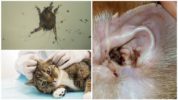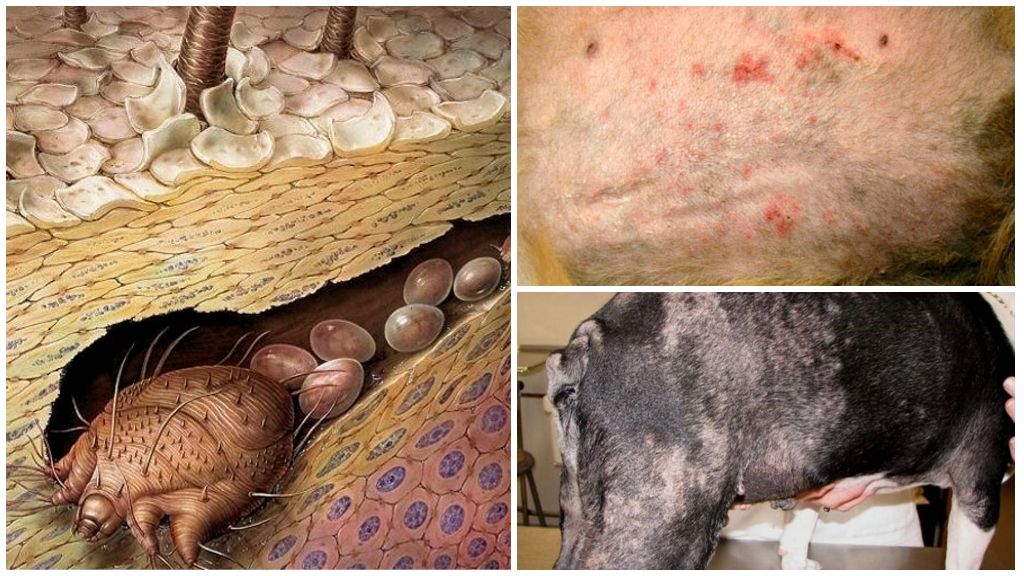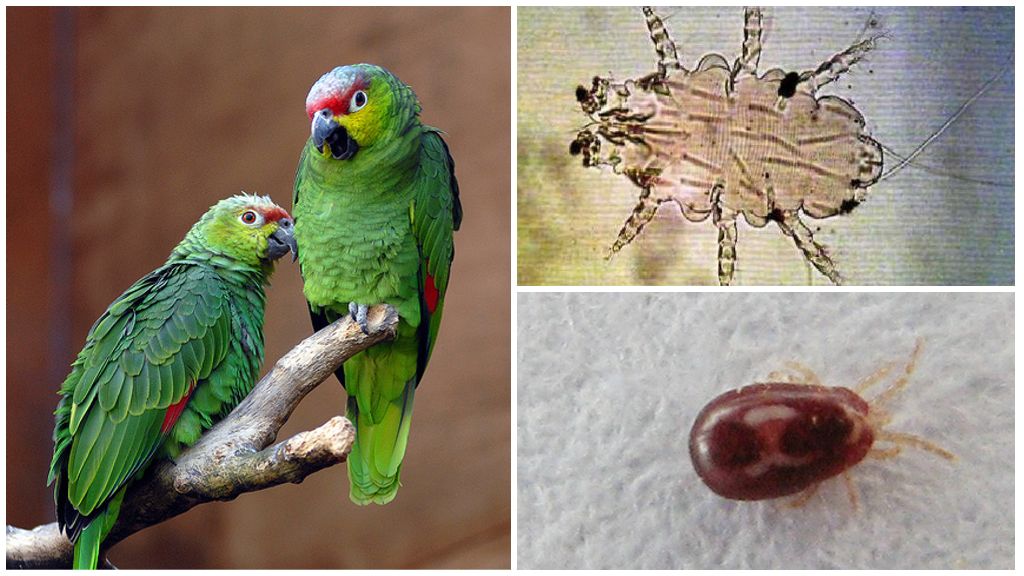- Ear mite in cats
- Treatment of otodectosis
- Drops for cats with otodectosis
- Alternative methods of treating otodectosis
The ear tick in cats is a disease that many owners of furry creatures have had to deal with. The cause of a pet's disease is a tiny arthropod. The exhaustion of blood, as well as the waste of its vital activity, is the cause of the inflammatory process of the auricle and excessive production of sulfur. As a result, the cat experiences severe discomfort and malaise. Therefore, every caring owner of a fourth friend should know how to treat an ear tick in his pet.
What does a parasite look like
Ear tick or otodectosis is a fairly common disease, which affects not only stray animals, but also pets. It is caused by Otodectes cynotis - a small light yellow creature whose length does not exceed 0.6 mm. The nondescript carrier of infection has relatively long legs and an oval-shaped body (a photo of the ear tick in cats is presented below).
On a note!
The parasite living in the upper layers of the auditory meatus uses not only skin cells, but also lymph, as well as intercellular fluid and blood, which causes the cat a lot of suffering. The development cycle of a bloodsucker is about 3 weeks. Outside the body of an animal, an arthropod can live for no more than two months. In the absence of food sources (victims), the pest dies.
How an animal can get infected with an ear tick
Infection of a pet can occur not only during contact with a sick relative, the parasite can penetrate the apartment and attack the animal in various ways:
- the use of common items for the care of animals (comb, towel, dishes);
- the fluffy owner himself may become a carrier, bringing the pest to the house on clothes or shoes, however cat ear mite for human no danger;
- a rug near the door, which is rarely washed and treated with disinfectant solutions, can also be a haven for bloodsuckers;
- tick carriers can even be fleas and flies.
On a note!
Most often, an ear tick is observed in a kitten or in a weakened animal. More rarely, the parasite attacks adult cats and cats.
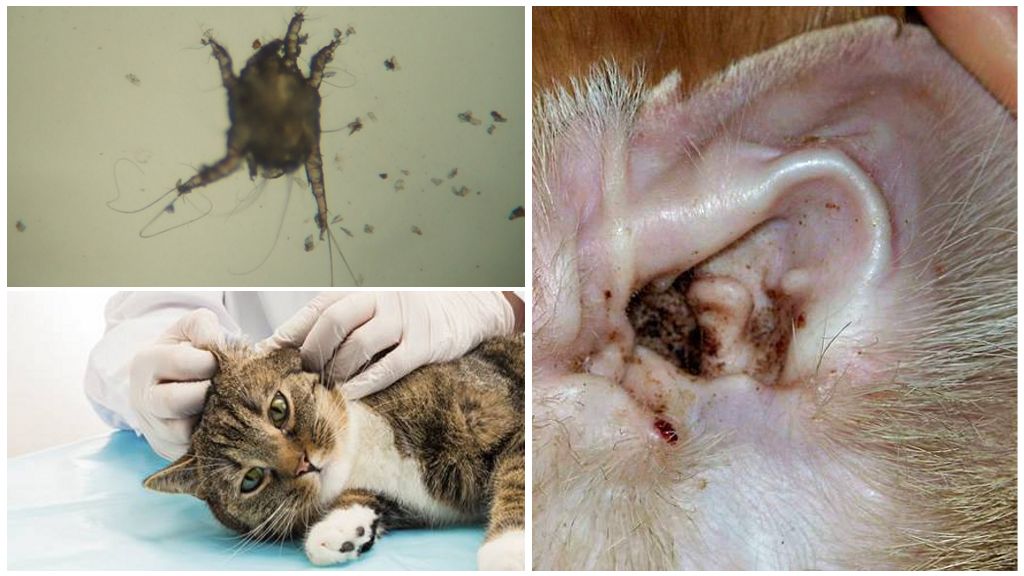
Symptoms of the disease
The fact that the cat got ticks in the ears is evidenced by the following symptoms:
- The inner surface of the ear is covered with black grainy plaque.
- Constant combing of the ears. Moreover, the animal can do this not only with its paw, but also crouching on hard surfaces. Due to intolerable itching, the cat becomes nervous and aggressive. Wounds appear on the site of the combs, which subsequently become inflamed and fester.
- Shaking the head also indicates a cat is infected with an ear tick. In this way, the animal seeks to get rid of the source of itching.
- The animal may have a fever, as indicated by the lethargic state of the pet.
- The presence of an unpleasant smell, palpable even at a distance.
If you do not provide the pet with timely help, then the disease will progress.In the advanced stage of the disease, the ears of the pet are filled with a large amount of sulfur, blood clots and feces of parasites. A plug forms in the ear canal, which will cause hearing loss. In addition, the cat begins to curve its neck, turning its head to its side and lowering it with a sick ear down.
Important!
The tick affects the external auditory meatus, the eardrum and the inner surface of the auricle, penetrating the inner ear. The result is an infection of the lining of the brain, which can lead to death of the pet.
Cat otodectosis: treatment
To make sure that an ear tick appeared in a cat or cat is not difficult at all. To detect the pest, cotton buds and dark tissue will help, against the background of which it will be easier to consider parasites. There are two ways to verify the presence of a tick:
- Having grabbed the ear secretions with a cotton swab, you should shake it over the decomposed matter, trying to shake off the pest. On dark fabric it will be clearly visible.
- You can consider the parasite in bright light, using a magnifier. It’s better to do it again against the background of dark fabric. You won’t have to doubt if you can notice the stirring in the sulfur-purulent mass.
To cure an ear tick, it is best to contact a veterinary clinic, where an experienced specialist will determine the type of pest and prescribe a suitable treatment option. After that, treatment at home will have to be done independently.
The main thing is to have patience, since the treatment of getting rid of parasites requires a lot of time and effort. However, the result will not be long in coming, it is only important to adhere to the following recommendations:
- The first stage is the removal of secretions and waste products of parasites that have accumulated in the ear canal. To do this, thoroughly clean the ears of the cat with hydrogen peroxide or lotion.
- The next step is the treatment of the inner surface of the ear with a medication prescribed by your doctor (ointment, drops or spray), which will contribute to the healing of the resulting wounds.
- To relieve itching, you can give your pet an antihistamine, and to prevent the cat (cat) from combing the affected area, use a special collar.
- After that, the cat's body is treated with acaricidal compounds, which can not only get rid of pests, but also prevent the attack of new parasites.
- If the house contains several pets, healthy should be isolated from the patient.
- Do not disrupt the medication prescribed by your veterinarian.
- Processing the apartment from an ear tick is also required, which will help limit the spread of pests.
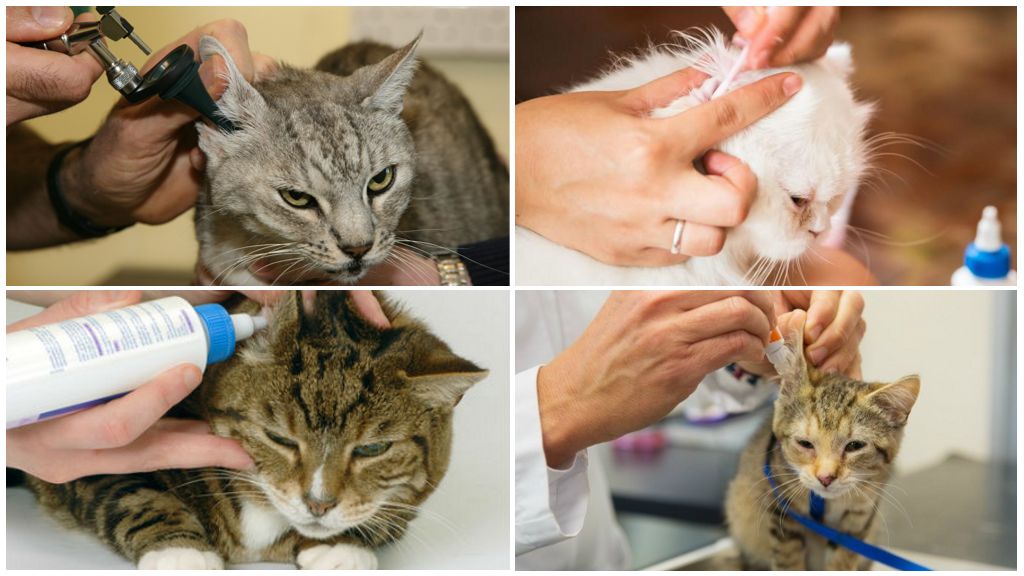
How to clean your cat’s ears
To remove ticks, you must be able to properly clean the ears of a cat.
- To carry out this procedure, a cotton pad is used, which is saturated with lotion.
- Then they are carefully carried out along the visible surface of the auditory canal.
- Next, the ear is clamped and massaged for several seconds.
- Then you need to clean the surface of the sink with a clean cotton pad.
Such manipulations are carried out several times until the inner surface is completely cleaned of sulfur emissions and waste products of pests. Then you can proceed to the application of medicines.
On a note!
To prevent the development of the disease, experts recommend cleaning both ears, regardless of which one is infected with a tick.
Medications
Treatment at home for an ear tick in cats involves the use of a drop, sprays and ointments.
Drops
Drops are one of the most common ways to remove ticks. They can also treat cat otitis media caused by a tick.
Drops are of both a highly specialized type (Ordermil) and a wide spectrum of action (Oricin).
- Tresaderm drops are harmful for eggs and adult parasites, thanks to the antibiotic that is part of them.Otoferonol and Tsipam drops are no less effective.
- The effectiveness of a particular composition depends on the degree of infection of the cat with an ear mite. With a small spread of insects, it is sufficient to use drops of insignificant concentration such as Leopard or Amit.
- Amitrazine drops are well removed for itching and the inflammatory process. Similar properties of drugs are usually not very expensive and are in great demand.
- Kittens are usually used to treat drops front line or Vedinon Plus.
On a note!
Due to their popularity, drops from the ear tick have a lot of falsifications. Therefore, in order not to become a victim of fraud, you should purchase the product in specialized stores.
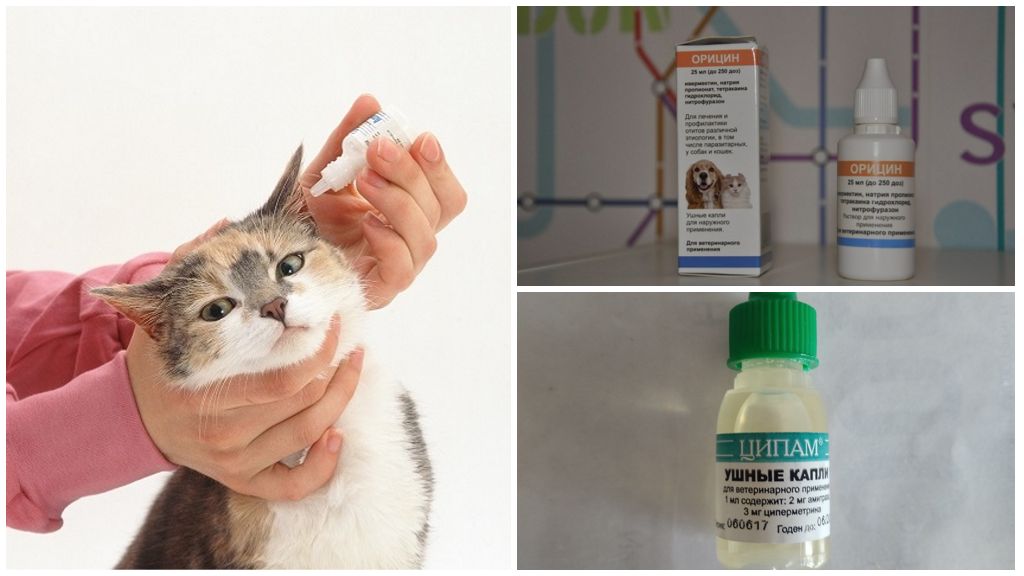
When using such formulations, it is important not to exceed the dosage indicated in the instructions. In addition, you should not use one drop all the time, this can cause irritation and severe allergies in the pet.
Ointments
You can also treat cat ear mites with ointments or gels. Their benefits include a prolonged prolonged effect. The disadvantage of such funds is the difficulty of applying creamy formulations.
One of the best-selling drug is Aversectin ointment. Its basis is prednisolone, so the drug has an acaricidal effect. The ointment is applied to the tampon and the ears are treated with it twice a day. Vedinol Plus, Amidel-Gel or Oridermil cream has similar properties.
Aerosols
A cat or cat ear mite is also treated with spraying agents that are applied to the inner surface of the animal’s ear. First, the auricle should be cleaned of secretions and waste products of the pest.
On a note!
When spraying the composition, it is important to prevent it from falling outside the surface to be treated, since the insecticide that has settled on the body can be subsequently mucous to animals. Therefore, it is better to use a cervical collar when spraying the composition, which is removed from the cat after the agent has completely dried.
The most popular sprays include: Ivermek and Acaromectin.
Folk remedies

A more gentle way to treat a cat is to use traditional folk remedies. They can be used both independently and in combination with a medicinal ointment, drops or spray.
- Effective against ticks celandine, or rather its juice. To prepare it, use the stems and leaves of the plant, which are passed through a meat grinder. The resulting mixture is squeezed and used for instillation into the ears (2 drops 2 times a day).
- Garlic. The vegetable, known for its antiseptic properties, is also used to remove ticks. Raw materials are crushed and poured with almond, olive or sunflower oil. After a day, the mixture is filtered and instilled in both ears, 2 drops 1 time per day.
- Green tea has no less effective anti-inflammatory properties. With hard tea leaves, the ears of an infected animal are buried at least 3 times a day.
- Iodine-glycerin infusion. To treat the ears of a cat, you can use a solution prepared from iodine and glycerol, taken in a ratio of 1: 4. Processing the composition is carried out 1 time per day.
On a note!
Do not replace the use of pharmaceuticals with folk with a high degree of infection of the cat with an ear tick.
Ear tick prevention
Preventive measures are to limit the contact of the pet with stray animals, street clothes and shoes of the owner, a rug at the front door. A thorough examination of the cat after a walk will help prevent the spread of pests.
Problems will not arise if the owner knows the symptoms and treatment of the ear tick in cats. Only timely and high-quality therapy will help restore the health of the pet.
